Choosing the right flooring for your bathroom is one of those decisions that can either make your life easier or become a long-term frustration. In Southern Ontario, where homes range from historic builds to newer developments, bathrooms need flooring that can handle moisture, temperature shifts, and everyday wear, without falling apart after a few winters.
At Rich Home Inc., we’ve seen firsthand what happens when the wrong material is used in the wrong environment. We’ve also helped homeowners select and install floors that look great, function even better, and last for years. If you’re thinking about updating your bathroom flooring, here’s everything you need to know before making your choice.
What Do Homeowners in Southern Ontario Need from Bathroom Flooring?
Bathrooms in this region face some specific challenges:
- Cold winters and humid summers can cause expansion, contraction, or condensation
- Many older homes (especially in Hamilton) have uneven subfloors or poor ventilation
- Newer homes (in Burlington and Oakville) often come with basic builder-grade finishes
- Daily use, wet feet, and steam create a consistently moist environment
Because of this, the best bathroom flooring isn’t just about what looks good, it has to stand up to water, stay stable under temperature swings, and be easy to clean. In Southern Ontario, bathroom floors have to do more than just look polished in photos. Between long winters, humid summers, and the daily realities of family life, materials are constantly being tested. Cold weather can cause contraction, while summer humidity brings expansion and condensation, a combination that can crack tile grout or warp cheaper flooring over time.
When you’re investing in bathroom updates, whether it’s a simple refresh or a full bathroom upgrade, flooring becomes one of the most important choices you’ll make. It needs to hold up to steam, water, and temperature swings while matching the look and feel of the space. Not every product on the shelf is built to handle that. The right flooring should feel durable, stay stable year-round, and stand up to daily use without constant upkeep.
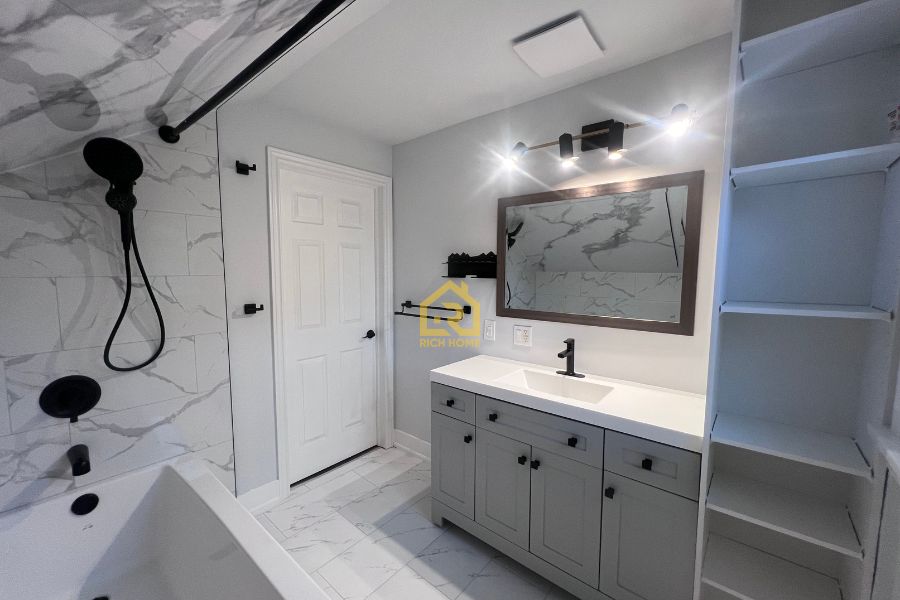
What Flooring Options Are Commonly Used in Bathrooms?
Porcelain or Ceramic Tile
Tile is the most common choice, and for good reason. It’s durable, waterproof, and works well in every type of home.
Why tile works well:
- Completely waterproof when installed properly
- Available in thousands of colours, patterns, and finishes
- Great for resale value in mid- to high-end homes
Things to watch for:
- Cold underfoot, unless paired with heated floors
- Slippery if glazed or polished
- Requires proper subfloor leveling in older homes
Cost range: $4–$12 per sq. ft. (material only)
Luxury Vinyl Plank (LVP) or Vinyl Tile
Vinyl has come a long way and is now one of the top choices for bathrooms in budget-conscious or family homes.
Why homeowners choose it:
- Fully waterproof and softer than tile
- Warmer to walk on, great for upgrading a basement with bathrooms
- Comes in wood-look and stone-look finishes
Watch out for:
- Cheap vinyl can peel or shift over time
- May not add as much resale value as tile
Cost range: $2.50–$6 per sq. ft. (material only)
Laminate Flooring
Laminate is one of the most common mistakes we see in bathroom projects. Even moisture-resistant versions are risky in a high-humidity space.
Why it’s a gamble:
- Not fully waterproof, moisture can get into the seams
- Tends to swell or warp with repeated exposure to water
- Often used in flip homes, not long-term ones
Cost range: $1–$4 per sq. ft.
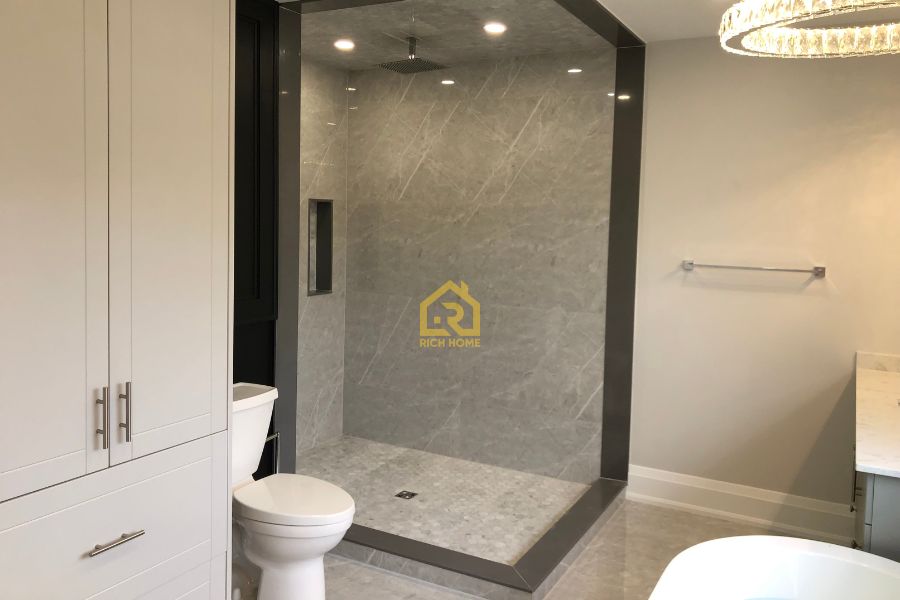
Hardwood and Engineered Wood
Real wood is a luxury look, but it’s not a practical bathroom material, especially not in full baths with showers or tubs. Even when properly sealed, hardwood is vulnerable to warping, staining, and moisture damage over time. We’ve seen many homeowners consider wood when installing freestanding tubs, and while the aesthetic can be beautiful, the constant exposure to water around the base can quickly become a problem. If you’re set on wood, consider using it in a powder room or pairing it with an ultra-reliable waterproofing strategy, but know it’s often more maintenance than it’s worth in full bathrooms.
Risks with real wood:
- Warps and discolours over time
- Prone to gaps and cracking in cold months
- High maintenance
When it’s used: Mostly in powder rooms with no shower
Cost range: $6–$14 per sq. ft.
Natural Stone (Slate, Marble, Travertine)
Stone floors are elegant and high-end, but they require sealing and careful upkeep. We see these most often in luxury Oakville homes.
Pros:
- Beautiful, unique look
- High resale value when maintained well
Cons:
- Porous and needs regular sealing
- Can be very slippery and cold
- Higher upfront cost
Cost range: $8–$20 per sq. ft.
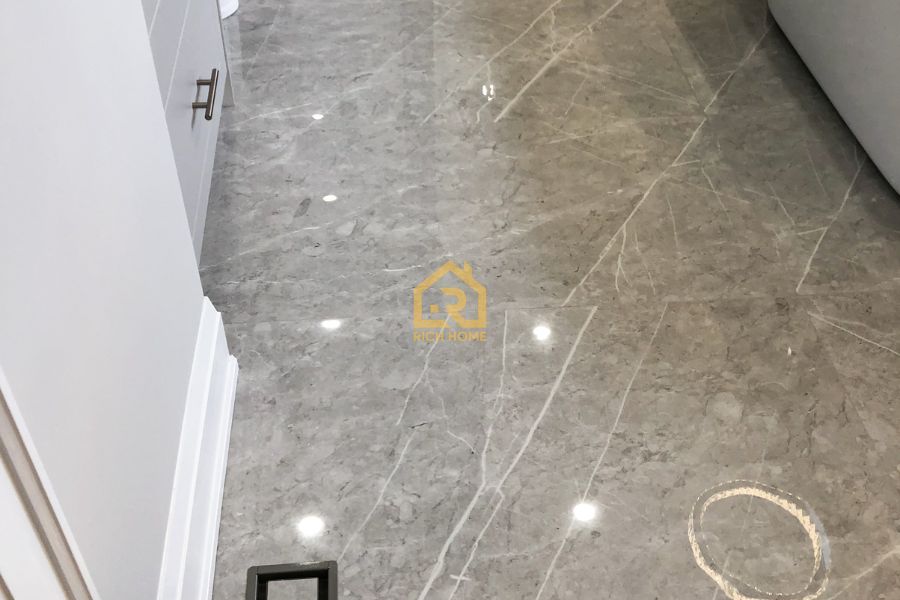
Comparing the Top Bathroom Flooring Options
Here’s a breakdown of the most commonly used flooring types, how they perform, and what you can expect to spend:
Flooring Type | Cost (Material Only) | Water Resistance | Comfort Level | Resale Value | Recommended Use |
| Porcelain Tile | $4–$12/sq. ft. | Excellent | Cold | High | Full bathrooms, heated floors |
| Ceramic Tile | $4–$10/sq. ft. | Excellent | Cold | High | All bathrooms |
| Luxury Vinyl Plank | $2.50–$6/sq. ft. | Very Good | Warm | Moderate | Family baths, basements, DIYers |
| Laminate | $1–$4/sq. ft. | Poor | Warm | Low | Not recommended |
| Hardwood | $6–$14/sq. ft. | Poor | Warm | Moderate | Powder rooms only |
| Natural Stone | $8–$20/sq. ft. | Good (sealed) | Cold | High | High-end bathrooms, spa-style |
What Flooring to Avoid (And Why)
Not everything sold as “bathroom-safe” actually holds up in real-world conditions. In our experience, these are the materials to avoid:
- Laminate: Even moisture-resistant options fail over time when exposed to regular humidity
- Hardwood: Vulnerable to warping, gapping, and mould under the surface
- Peel-and-stick vinyl: Often used in rentals or DIY flips, but fails quickly in busy bathrooms
If your flooring starts to lift, feel soft, or smell musty, it’s often a sign of hidden damage underneath, especially in homes without exhaust fans or proper ventilation.
What Type of Flooring Is Best for a Tight Budget?
If you need something affordable but still durable, high-quality vinyl is your best bet. It’s waterproof, easy to install, and available in a huge range of looks.
Why we recommend vinyl for budget-conscious projects:
- Can be installed over existing floors in many cases
- Requires less labour than tile
- Holds up to pets, kids, and moisture
Avoid choosing vinyl based only on price. The ultra-cheap stuff doesn’t last, peels at the edges, and often has a plastic feel underfoot.
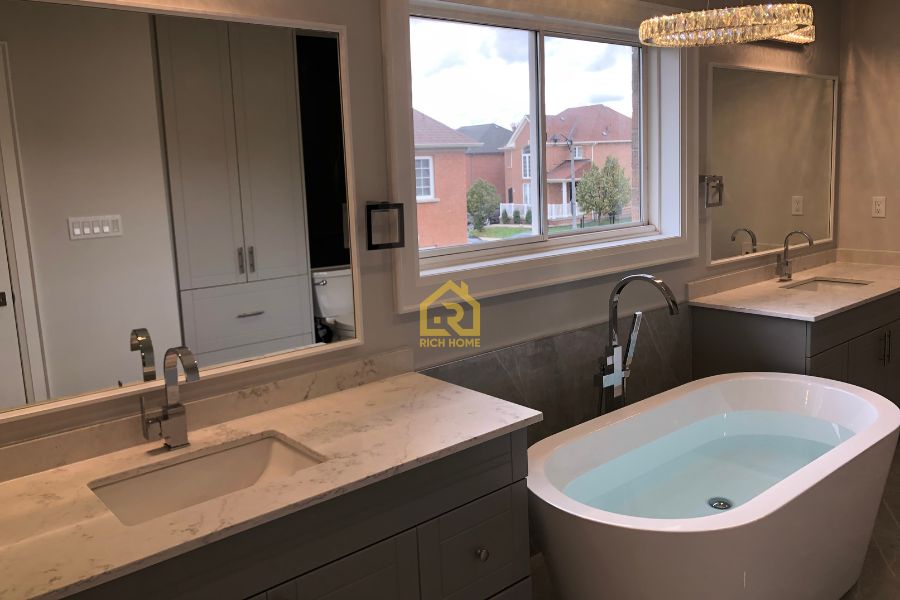
What Type of Tile Should You Choose?
If you’re going the tile route, porcelain is the most reliable option. It’s denser than ceramic and absorbs less moisture, which makes it perfect for bathrooms. Large-format tiles with minimal grout lines are trending in newer Burlington and Oakville homes, they’re easier to clean and make the space feel larger.
Here’s what to keep in mind when choosing tile:
- Always go for a slip-resistant or matte finish to prevent falls
- Use epoxy grout in wet zones, it resists stains and won’t crumble
- Install radiant floor heating if you want warmth underfoot in winter
What Bath Flooring Performs Best in Older Homes?
Many older homes in Hamilton have quirks like sloped subfloors, creaky joists, or even asbestos tile under layers of old flooring. This can complicate tile installation unless the surface is fully prepped.
In these homes:
- Vinyl is often the most forgiving and practical option
- If choosing tile, budget for levelling compound or new cement board
- Ensure ventilation is upgraded to protect your new floor from condensation
Choosing Bathroom Flooring for Families or Aging-in-Place
In busy households, durability and safety matter just as much as looks.
For families:
- Vinyl and tile are the easiest to maintain
- Choose flooring that resists scratches and is easy to clean
- Avoid slippery materials like polished stone
For aging in place:
- Textured tile or slip-resistant vinyl reduces fall risk
- Keep transitions between rooms low for better mobility
- Consider comfort and warmth underfoot for bare feet
How To Know When It’s Time To Replace Your Bathroom Flooring
Some signs are obvious: cracked tiles, lifting corners, peeling vinyl. But others are more subtle, persistent smells, darkened grout lines, soft spots underfoot. If your floor feels “off” or shows visible damage, it’s often cheaper to replace it now than to deal with underlying issues like mould or subfloor rot later. There’s a lot to consider when choosing flooring for a bathroom, especially in a region like Southern Ontario, where seasons shift quickly and homes vary widely in age and construction. The wrong flooring can lead to damage you won’t notice until it’s too late, but the right flooring can keep your bathroom looking sharp, staying safe, and functioning perfectly for years to come.
At Rich Home Inc., we help homeowners in Burlington, Hamilton, and Oakville make smart, long-lasting flooring choices that actually work for their space. Whether you’re redoing a main bath, finishing a basement, or just replacing that old vinyl, our team can help you choose materials that look beautiful and stand up to real life.
Ready to explore flooring options that make sense for your home? Reach out, we’ll walk you through it.
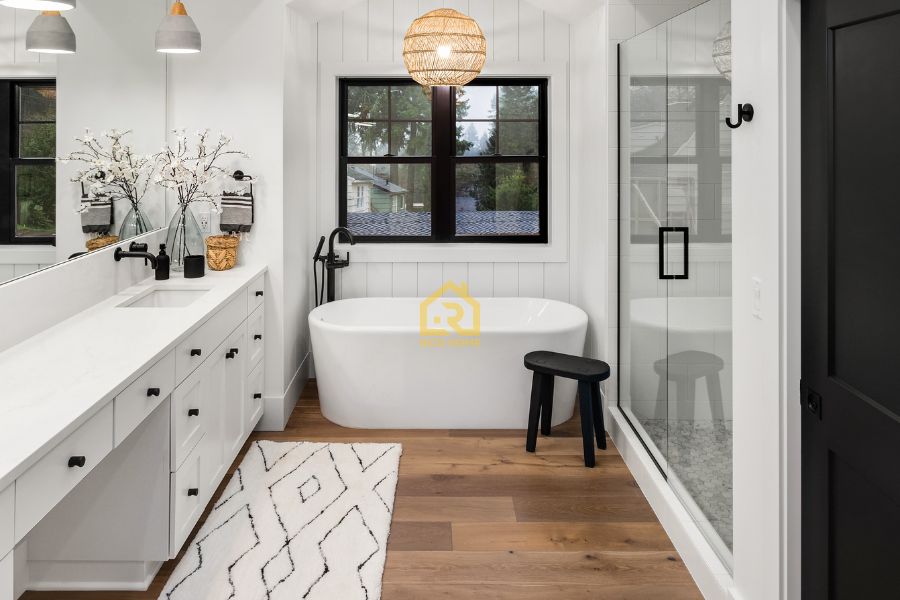
Areas We Serve
We are proud to offer our Home Renovation services in the following areas:
Hamilton
Burlington
Oakville
Milton
Mississauga
Toronto
Contact Info
Send us a message or call us and we’ll get back to you as soon as we can.
Valid until end of month
book now for SPECIAL saving!
free estimate
(647) 994-1439
have a questions?
info@richhomeinc.ca
Get Started Today
Transform your home with Rich Home Inc. Contact us now for a free consultation and begin your renovation journey!